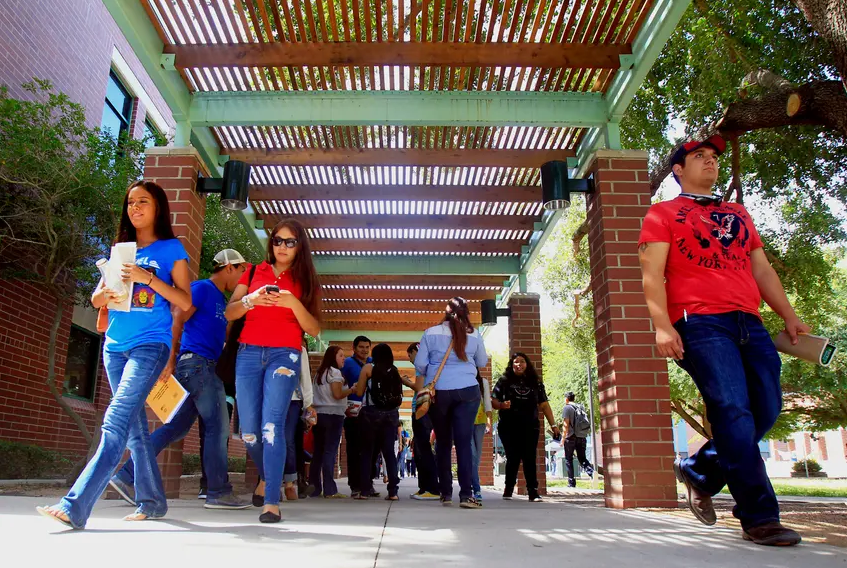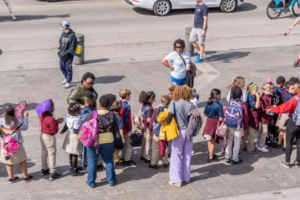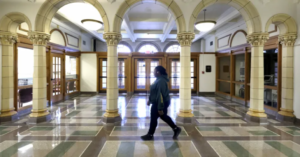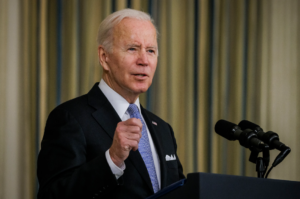Texas created a program to help students reenroll in college during the pandemic. Schools struggled to find students who qualified.
12 min read
When the federal government handed Gov. Greg Abbott $307 million in the spring of 2020 to help Texas’ education systems survive the COVID-19 pandemic, he set aside $47 million specifically for former students, those who had earned some credit but left before finishing their degree or certificate.
There are 4 million Texans who have some college credit but never earned a credential. It’s a group that the state higher education leaders want to bring back into the classroom to learn new skills and fill high-demand jobs across the state. That interest has only heightened during the pandemic, especially at Texas’ community colleges, which have experienced staggering enrollment declines.
With that $47 million from the Governor’s Emergency Education Relief Fund in hand, The Texas Higher Education Coordinating Board — the state agency that oversees Texas’ colleges and universities and manages the state’s financial aid program — created the Reskilling Support Fund Grant Program.
The agency’s goal was to put this money in the hands of as many as 30,000 students by February 2022, according to a presentation on its website. When it asked schools to apply for the first two rounds of grant funding, state leaders emphasized the importance of getting the money to students as fast as possible, given the high unemployment rate and large number of displaced workers.
“Indeed, these are emergency funds,” Sheri Ranis, the coordinating board’s assistant director for innovation and advancement, told college leaders in a Zoom meeting in late 2020. “Those who are able to get more money out the door more quickly are going to get bonus points for that.”
But in the year since that money was first distributed, the 64 colleges and universities that received grants have awarded money to only one-third of the 18,000 students that they collectively told the state they could help reenroll, much lower than they predicted and far from the state’s vision to provide 30,000 students with this funding.
While a few colleges have enrolled hundreds of students, most schools have helped a fraction of the number of students they claimed they could, according to a Texas Tribune analysis of reports submitted by each school to the state. At the end of 2021, four schools that received money had yet to award it to a single student.
Multiple college leaders blame the slow ramp-up on extremely strict requirements initially handed down by the state that limited exactly who qualified for a grant and when the money could be used. It made it nearly impossible to distribute funds to potential students.
“It was like we were on a hunt for a unicorn,” said Marlo Bitter, spokesperson with Trinity Valley Community College in Athens, where money has been distributed to 22 of a projected 400 students as of the last report to the state. At the end of the semester, schools will submit reports detailing how many students they awarded money for the spring.
In turn, the state was forced to relax program requirements twice last year to try to make it easier for schools to award money to students.
And earlier this month, the coordinating board expanded the requirements yet again, after weeks of questions from the Tribune about the reasons behind the program’s structure.
State higher education officials largely defend their efforts. And, to be sure, reengaging students who have left college before finishing is a challenge that schools across the country have yet to solve.
But Texas Higher Education Commissioner Harrison Keller said the struggle to award this grant funding revealed an overall lack of infrastructure within Texas colleges and universities to connect with nontraditional students who tend to be older than a student enrolling immediately after high school.
“These were wake-up calls for us,” Keller said. “No institution that I talked to felt like that was something that they were very good at. … This is something that we have wrestled with.”
Immediate struggles to find students
To apply for this money, Texas colleges and universities had to include in their application the minimum number of students they believed they could identify and reenroll, using this money to help pay the student’s tuition and fees.
So far, the state has awarded the money to schools in three different rounds.
Larger schools like Dallas College and El Paso Community College said they could help at least 1,000 students. They received $1.5 million during that first round of funding. Smaller schools like Panola College in East Texas and Texas Southmost College in Brownsville said they could help at least 75 students. Those schools each got $112,500.
But from the start, some school leaders said they realized quickly it would be a struggle to find those students.
“We knew what we were getting into when we applied for it just because it certainly was a challenging set of requirements,” said Jay Corwin, chief student success officer at Collin College, which banded together with a group of North Texas schools to launch a joint program called Project Complete. “But, you know, once you found a student that was eligible, it was really exciting.”
At first, students had to be within a year of finishing their program and left college more than six months ago. They had to enroll in high-demand programs and qualify for at least $500.
This money was available only after they exhausted other funds, like federal and state financial aid programs. Students also had to show they were impacted by the pandemic. After all that, students could receive a maximum of $2,500.
According to those running the programs, the reasons students didn’t qualify for the program varied. Some students were discouraged when they tried to first fill out the federal financial aid application known as FAFSA. Others had outstanding debts they needed to pay the schools before they could start classes again. Or their GPA had dropped too low to qualify for money. Others were too far away from finishing their programs to qualify. For some, they had dropped out too recently.
“[It] was a little difficult to get a lot of our students to check every single box,” said Tim Clark, head of enrollment services at Odessa College, which has awarded pandemic reskilling money to only 46 of the 2,000 students it originally hoped to find by the end of 2021.
Clark also said tuition and fees are so low at Odessa that many students didn’t need the money. In some cases, students didn’t qualify because they needed less money than the $500 minimum set by the state.
And these were the issues that arose when students did apply. Many colleges said lots of former students just didn’t respond when they reached out via postcard, email or phone call.
April Felan-Butler runs the reskilling grant program at San Jacinto College outside Houston, which has distributed money to 50 students out of 665 they told the state they could help.
She said students were sometimes caught up in a small but vital bureaucratic detail: She couldn’t actually confirm if they qualified for the grant unless they officially enrolled. Sometimes she said students weren’t ready to reenroll because they didn’t know if they could actually afford to pay.
“It’s like, well, there’s no guarantee that I’m going to get this grant,” she said students would tell her, explaining their hesitancy to go through the process without the assurance that tuition and fees would be covered.
Many leaders said lots of students remain unconvinced this is the best time to return to school as they continue to balance child care, jobs or housing insecurity made worse by the pandemic.
“The least little thing can derail them,” said Gloria Smith, associate vice chancellor of career connected learning at Dallas College, which has awarded 65 students grants out of 1,000 it received money to serve.
“The mindset is, ‘Oh, let’s just give them money. Let’s get them reskilled and this should work.’ But I think people, depending on how COVID has impacted them … education in general, it’s just not at the top of their list right now,” Smith said.
Learning how to communicate with older students
The reskilling grant funding was not the only aid that schools could provide students to help pay for school during the pandemic. Abbott allocated money to schools to provide other emergency aid to students, but also to help schools boost their online learning programs and data infrastructure.
But the reskilling money was unique because it allowed Texas to target noncompleters, a group that state leaders know they must reengage to help employers hire the workers they need. And especially if they want to reach a previously stated goal that 60% of 25- to 34-year-olds hold a certificate or college degree by 2030.
Noncompleters tend to be older students who stopped attending school because of finances or class schedules that don’t mesh with their other responsibilities, like child care or work.
School leaders said they quickly learned that messaging to older students required a different approach than a student coming right from high school.
At El Paso Community College, financial aid director Ines Lopez said when her school system initially emailed 5,000 students about the reskilling grant program, they received few responses.
When Lopez’s 24-year-old son, who has a bachelor’s degree, saw a flier for the grant at home, he pointed out a crucial issue: He said he didn’t know what reskilling meant.
“Students see reskilling as a scary word,” Lopez said. “Our older population of students — they’re still students, they’re diverse. It might be how we’re marketing, how we’re not enticing [them]. Maybe it’s not for them because it’s a word they don’t understand. We need to say something like, ‘You’re so close to finishing. We could help you cross the finish line.’”
The school changed the way they worded their messaging and added photos of older adult students to postcards and then they sent them to potential awardees. As of December, El Paso Community College had given grants to 88% of the 1,075 students they pledged to help.
In North Texas, Collin College and its nearby partnering schools have awarded money to nearly three-quarters of the 1,450 students they said they could reenroll. They credit the decision to pool their resources and market the program under the same name, Project Complete.
“It makes more sense to market for completing your degree in North Texas than it does to say, ‘complete your degree at this institution’ and have six different entities out there saying the same thing with a different logo on the bottom,” Corwin said.
Other college leaders said they changed their marketing tactics for the reskilling grant program because of feedback from older students.
While younger students prefer to text or email and embrace communicating over social media, older generations want something more tangible, said Kelley Townsend, associate vice president for workforce education at Trinity Valley Community College.
“We do have these working students that are coming back [and] going, ‘I don’t have time for that. I need you to send me something. I need you to call me. I need you to have a flier I need,’ she said. “So they’re old-school, and that’s OK, too.”
Students need more than money
While a major emergency like the COVID-19 pandemic might bring an influx of funding, experts say money isn’t enough to entice nontraditional students to return to college.
“You can’t wait until there’s an emergency to then try to establish these communication lines,” said Oscar Sweeten-Lopez with the Michael & Susan Dell Foundation, an expert who works to improve graduation rates among students facing challenging conditions. “If those communication lines haven’t been established, and just with the added complexity of everyone’s lives with COVID, it’s just a very challenging environment to have the success that I think people had anticipated or hoped for.”
Lexi Anderson, a policy director at the Education Commission of the States who has studied noncompleters, said states trying to target students who have dropped out need to spend time trying to deeply understand why students left college, knowing “that not just money will fix it.”
“You have to have that next-level conversation with former students,” she said. “And ask ‘Is this what you want? Is this the kind of program that’s going to help you?’ and ‘What do you need support-wise now that you didn’t have then?’”
A few states — including Texas — have tried to make it easier for these students to return to college over the past decade. Anderson said states that have successfully brought older students back to school have done it in a centralized way rather than allowing schools to individually do so, like the Texas reskilling program model.
In 2016, Indiana launched a program to encourage students to return to college called “You Can. Go Back.” State higher education officials created a statewide financial aid program to support older students specifically rather than allowing individual schools to run their program. As of 2020, more than half of the 19,000 students who reenrolled had finished their programs, according to the Associated Press.
Launching a central program also creates a more unified way to market the opportunity and it allows the state to use other statewide data sources to track down former students. Yet this grant program in Texas provided some lessons to some colleges and the state to become more student-ready.
This fall, Trinity Valley Community College will start to offer night and weekend courses to accommodate older student schedules. Townsend said older students are less likely to be able to attend classes in the middle of the day.
Keller, the higher education commissioner, said the coordinating board made changes as a result, too. This fall, the state is launching an advising tool called My Texas Future. Now, the new portal will first prioritize older students and help them find the best program that meets their needs and particular situation.
“We realize we punted this to institutions, historically, far too much and relied on Google,” Keller said. “They’ll Google around to look for different programs that might be a fit. And that’s not going to be effective for addressing the kind of challenges that we face, especially for helping folks identify programs that would translate the real value and opportunities for them and their families.”
Countdown to September
According to The Hunt Institute, which has tracked how state governors have allocated this federal COVID-19 funding for education, few states used this money for higher education. Many used the funding for K-12 school systems.
Any unspent COVID education dollars must be returned to the federal government. In Texas, colleges that received money from the reskilling program have until September to award the grant money to students or the state will have to return it to Washington. The coordinating board had originally told schools to award all the money by February of this year.
In January, the coordinating board awarded a third round of funding to schools that must also be dispensed by the end of September.
Keller insists the state would not send any money back to the federal government. He said any money that schools can’t use could be redirected to other colleges or universities. Or they could change requirements again.
But as the state expands the eligibility requirements, it moves further away from helping the students it said it originally intended to serve: returning students who may have lost their jobs and could enroll in short-term credential programs to learn a new skill.
As the program stands today, the money can be used for any Texan who isn’t coming directly out of high school who wants to enroll and meets other basic academic and financial requirements. Schools can now also give this money to students enrolled in graduate programs, a large step away from the original intent to encourage displaced workers to enroll in short-term credential programs.
While Keller said students earning their master’s degrees and Ph.Ds likely would receive this funding only in rare cases, only three of the schools that received part of the $10.5 million awarded in the final round of funding earlier this year offer short-term credentials. Most schools that received funding were four-year universities, including for the first time two private universities: Our Lady of the Lake University in San Antonio and University of St. Thomas in Houston. It signals that this latest round of funding will be awarded to more students pursuing bachelor’s degrees or higher.
Despite the stumbles in launching this program, Keller remains positive. He was adamant that the trajectory of the reskilling grant program helped set the stage for a better conversation during the next Legislative session about what type of state investments higher education needs to properly meet the workforce needs of communities.
“If it all would have worked perfectly out of the box the first time, we wouldn’t have learned as much,” Keller said.
This article was originally posted on Texas created a program to help students reenroll in college during the pandemic. Schools struggled to find students who qualified.







